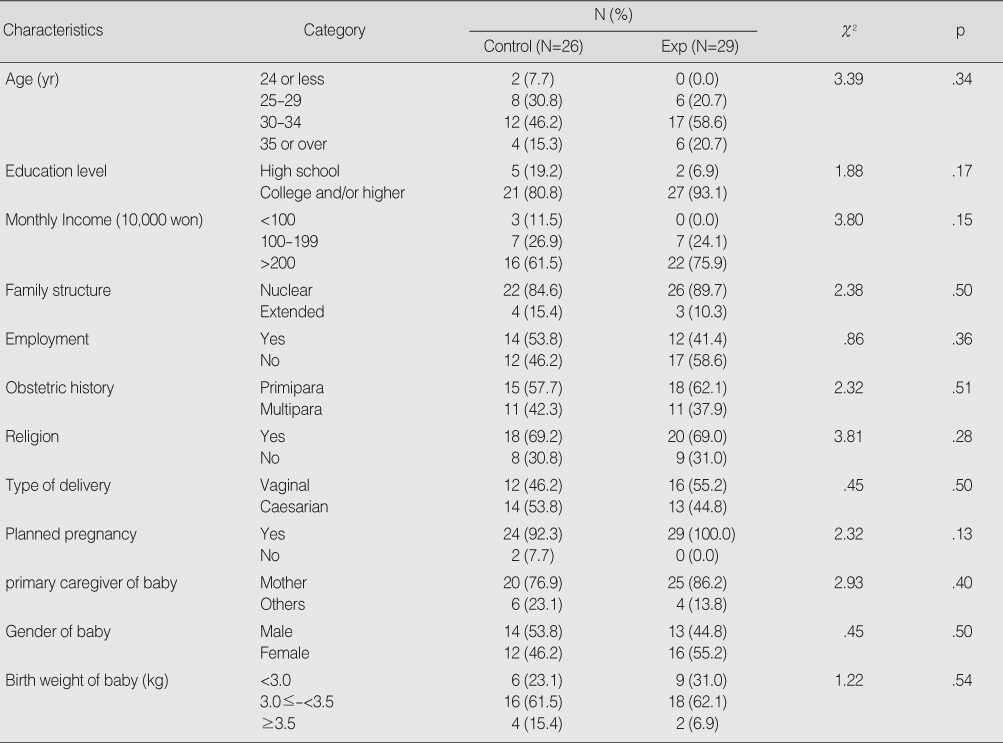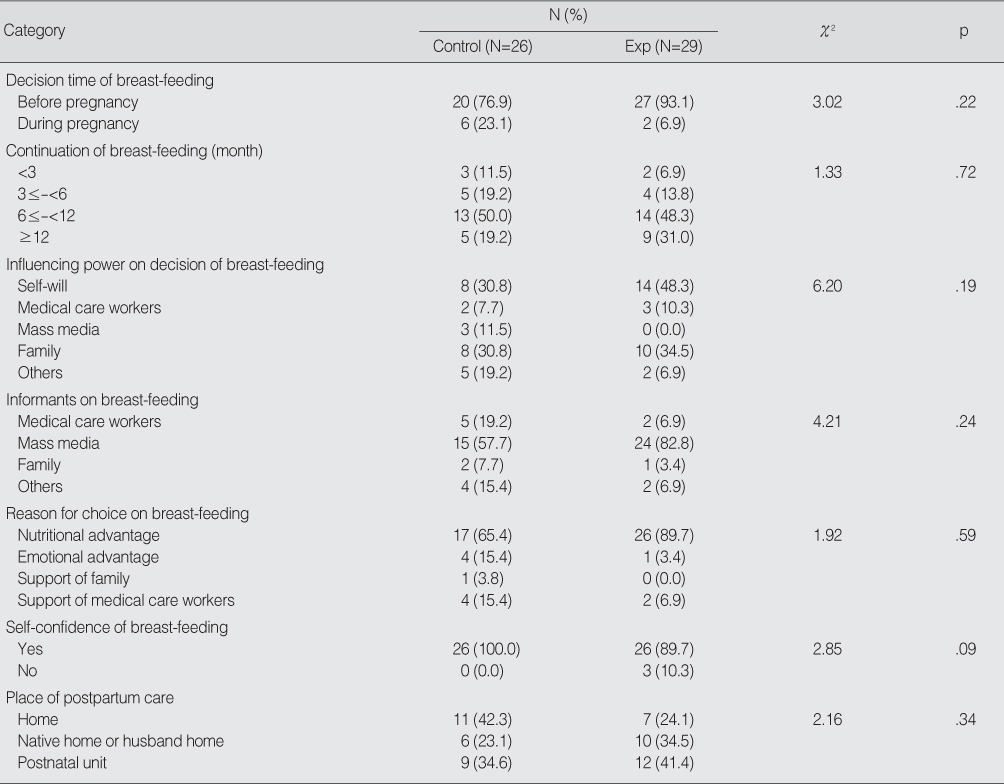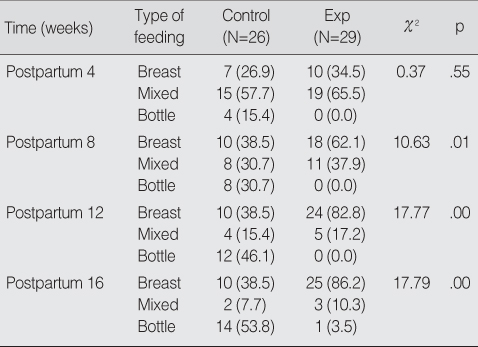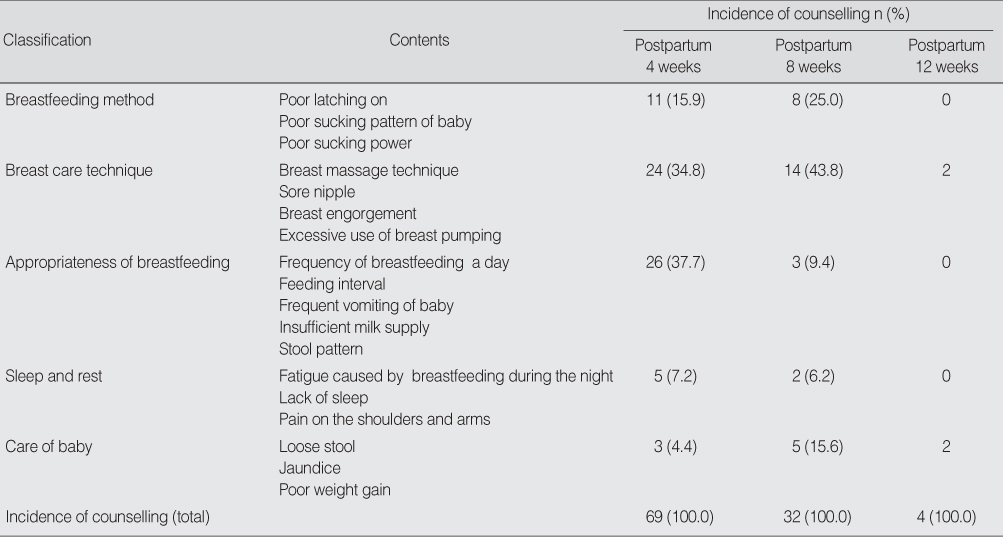Articles
- Page Path
- HOME > J Korean Acad Nurs > Volume 38(1); 2008 > Article
-
Original Article
- Effect of Postpartum Breast-feeding Support by Nurse on the Breast-feeding Prevalence
- Gun Ja Jang, Sun Hee Kim, Kyung Soon Jeong
-
Journal of Korean Academy of Nursing 2008;38(1):172-179.
DOI: https://doi.org/10.4040/jkan.2008.38.1.172
Published online: February 28, 2008
1Full-time Instructor, Department of Nursing, Daegu Polytechnic College, Daegu, Korea.
2Head Nurse, Kyungpook Natinal University Hospital, Daegu, Korea.
3Associate Professor, Department of Nursing, Kimcheon Science College, Gimcheon, Korea.
- Address reprint requests to: Jang, Gun Ja. Department of Nursing, Daegu Polytechnic Colleage, 395 Manchon 3-dong, Suseong-gu, Daegu 706-711, Korea. Tel: 82-53-749-7247, Fax: 82-53-749-7460, kjjang14@tpic.ac.kr
• Received: November 27, 2007 • Accepted: January 3, 2008
Copyright © 2008 Korean Society of Nursing Science
Abstract
-
Purpose
- The purpose of this study was to investigate the effects of the professional nurse's postpartum breast-feeding support on breast-feeding prevalence for mothers who delivered in Baby-Friendly Hospitals (BFH).
-
Methods
- This quasi experimental study was designed with a nonequivalent control group post test. The subjects of this study were 55 mothers who were hospitalized in the delivery room of a university hospital which was selected as a BFH in Daegu from October 1, 2005 to June 30, 2006. Twenty nine mothers were assigned to the experimental group and 26 mothers to the control group. Postpartum breast-feeding support by nurses' telephone calls to the experimental group was provided once a week for 4 weeks postpartum and then once a month for 16 weeks postpartum. Four post tests were given at postpartum week 4, 8, 12, and 16. The control group was given a telephone call at postpartum week 4, 8, 12, and 16.
-
Results
- The breast-feeding prevalence of the experimental group was significantly higher than that of the control group for each period.
-
Conclusion
- Postpartum breast-feeding support by nurses may be a useful intervention to increase breast-feeding prevalence.
- 1. Cohen J. Statistical power analysis for behavioral science. 1988;New York, Academic Press.
- 2. Guise JM, Palda V, Westhoff C, Chan BK, Helfand M, Lieu TA, et al. The effectiveness of primary care-based interventions to promote breast-feeding: systematic evidence review and meta-analysis for the US preventive services task force. Ann Fam Med. 2003;1(2):70–78.ArticlePubMedPMC
- 3. Hwang WJ. The study on the factors determining breastfeeding rate and duration. 2004;Seoul, Yonsei University. Unpublished master's thesis.
- 4. Jacknowitz A. Increasing breastfeeding rates: do changing demographics explain them? Womens Health Issues. 2007;17(2):84–92.ArticlePubMed
- 5. Jeon SY. Breast-feeding and care. 12th ann Korean Soc Perinatol. 2007;June:31–33.
- 6. Jeong GH. Effect of the nursing intervention program on promoting the breast-feeding practice in primipara. 1997;Seoul, Ewha Womans University. Unpublished doctoral dissertation.
- 7. Kang JS, Choi SY, Ryu EJ. Effect of a breastfeeding empowerment programme on Korean breastfeeding mothers: a quasi-experimental study. Int J Nurs Stud. 2007;45(1):14–23.PubMed
- 8. Kim HS. Analysis of the content of telephone counseling with breastfeeding mothers. J Korean Acad Nurs. 1995;25(1):17–29.ArticlePDF
- 9. Kim HS, Kovach AC. Information and social support regarding breastfeeding: a survey of mothers in Seoul, South Korea. J Korean Acad Nurs. 2001;31:1151–1159.ArticlePDF
- 10. Kim KA, Shin SM, Lee K. Evaluation of the effect of BFHI(baby-friendly hospital initiative) developed by WHO/ UNICEF. Korean J Perinatol. 2005;16(1):37–48.
- 11. 2004 Korean committee for Unicef: annual report. Korean Committee for Unicef. 2005;Retrieved from http://unicef.or.kr/unicef/board_ book/upload/2004_ar_KCU-Ko.pdf.
- 12. Park EO, Lee KS, Jang IS, June KG. Breast-feeding & breast-feeding health behavior among first-time mothers. Korean J Women Health Nurs. 2001;7:382–392.ArticlePDF
- 13. Park CM. A study on factors related to the practice of breast-feeding. J Korean Soc Health Educ Promot. 2002;19(2):23–43.
- 14. Park SH. The effect of breast-feeding education and follow-up care on the breast-feeding rate and the breast-feeding method: focused on home visit and phone counseling. 2001;Daegu, Keimyung University. Unpublished master's thesis.
- 15. Seo IS, Jung MS, Suh YS. Effect of education for encouraging breastfeeding on practice of breastfeeding. Korean J Women Health Nurs. 2000;6:632–642.ArticlePDF
- 16. Shin GY, Kim OJ, Park JH, Lee JR. Effects of rooming-in on continuation of breastfeeding and maternal identity. Korean J Women Health Nurs. 2002;8:402–411.ArticlePDF
- 17. Sung MH, Kim DH. Effects of breast-feeding education and continuous phone counseling on the promotion of breast-feeding compliance. J Korean Soc Matern Child Health. 2003;7:167–178.
- 18. UNICEF. Take baby-friendly initiative!. 1992;New York.
- 19. U.S. Department of Health and Human Services. HHS blueprint for action on breastfeeding. 2000;Washington, D.C., U.S. Department of Health and Human Services, Office on Women's Health.
- 20. Yeo JH. Influencing factors in breast feeding duration. Korean J Women Health Nurs. 2005;11:142–147.ArticlePDF
- 21. Yoo EK, Kim MH, Seo WS. A Study on the rate of breast-feeding practice by education and continuous telephone follow-up. Korean J Women Health Nurs. 2002;8:424–434.ArticlePDF
- 22. WHO/UNICEFF. Innocenti declaration on the protection, promotion, and support of breastfeeding. 1990;In: breastfeeding in the 1990's: a global initiative meeting in Florence, Italy and New York; Geneva, Switzland.Article
REFERENCES
Figure & Data
REFERENCES
Citations
Citations to this article as recorded by 

- Assessment of Knowledge on Baby-friendly Hospital Initiative among Staff Nurses in MCH Unit at MGMCRI, Puducherry, India
Priyalatha Ganesh, Rajeswari Subbarayan
Pondicherry Journal of Nursing.2019; 12(1): 8. CrossRef - Effects of Breastfeeding Empowerment Program on Breastfeeding Self-efficacy, Adaptation and Continuation in Primiparous Women
Seon Mi Song, Mi Kyung Park
Journal of Korean Academy of Nursing.2016; 46(3): 409. CrossRef - Comparison of Lactation Problems, Knowledge, and Adaptation on Breastfeeding between Users and Non-Users of Lactation Clinic
Myoung Hee Yun, Hye Sook Shin
Journal of East-West Nursing Research.2014; 20(2): 112. CrossRef - A Structural Model for Primiparas' Breastfeeding Behavior
Hyun-Joo Yang, Ji-Min Seo
Journal of Korean Academy of Nursing.2013; 43(3): 399. CrossRef - Breast Feeding Rates and Factors Influencing Breast Feeding Practice in Late Preterm Infants: Comparison with Preterm Born at Less than 34 Weeks of Gestational Age
Gun Ja Jang, Sang Lak Lee, Hyeon Mi Kim
Journal of Korean Academy of Nursing.2012; 42(2): 181. CrossRef - A Study on the Experience of Breastfeeding Education for Women with Children 24 Months of Age and Younger
Ji-Eun Kim, Dong-Yean Park
The Korean Journal of Community Living Science.2012; 23(4): 523. CrossRef - Exclusive Breastfeeding Rates of Breastfeeding-Willing Mothers and Its Influencing Factors by the 1st, 3rd, and 6th Month of Postpartum
이선옥, Kyung-Yeon Park, 나성순
JOURNAL OF THE KOREAN SOCIETY OF MATERNAL AND CHILD HEALTH.2012; 16(1): 44. CrossRef - Improvements of Behavior and Attitude of Pregnant Women Trained by A Maternity-oriented Antenatal Education Program: Assessment of Korean Gentle Birth (KGB) Program
김영란, 장우식, Sohn,Hae-Sook, 전채민, Chun Jin Ho, 민유선, 남문희
JOURNAL OF THE KOREAN SOCIETY OF MATERNAL AND CHILD HEALTH.2012; 16(2): 227. CrossRef - Types of Breastfeeding and its Predictors of Mothers in Twenty-four Months after Birth
Miyoung Kim, Sun Hee Kim, Ja Hyung Lee
Korean Journal of Women Health Nursing.2011; 17(1): 21. CrossRef - Effects of Breast Massage on Breast Pain, Breast-milk Sodium, and Newborn Suckling in Early Postpartum Mothers
Sukhee Ahn, Jinhee Kim, Jungsuk Cho
Journal of Korean Academy of Nursing.2011; 41(4): 451. CrossRef - Effects of Breast-feeding Education and Support Services on Breast-feeding Rates and Infant's Growth
Gun-Ja Jang, Sun-Hee Kim
Journal of Korean Academy of Nursing.2010; 40(2): 277. CrossRef - Factors Affecting Mother's Adaptation to Breastfeeding
Sun Hee Kim
Journal of Korean Academy of Nursing.2010; 40(2): 225. CrossRef - Factors Explaining Mothers' Breastfeeding Satisfaction
Sun Hee Kim
Korean Journal of Women Health Nursing.2009; 15(4): 270. CrossRef
Effect of Postpartum Breast-feeding Support by Nurse on the Breast-feeding Prevalence
Effect of Postpartum Breast-feeding Support by Nurse on the Breast-feeding Prevalence
Homogeneity Test on General Characteristics (N=55)
Homogeneity Test on Breast-feeding Information (N=55)
Comparison of the Breast-feeding Prevalence between Two Groups
Comparison of Feeding Type between Two Groups
Telephone Counseling Contents
Table 1
Homogeneity Test on General Characteristics (N=55)
Table 2
Homogeneity Test on Breast-feeding Information (N=55)
Table 3
Comparison of the Breast-feeding Prevalence between Two Groups
Table 4
Comparison of Feeding Type between Two Groups
Table 5
Telephone Counseling Contents
 KSNS
KSNS
 E-SUBMISSION
E-SUBMISSION





 Cite
Cite

